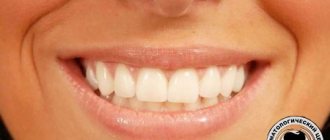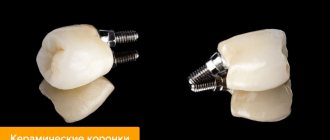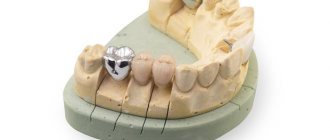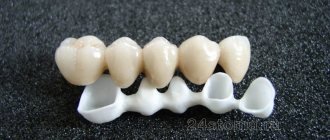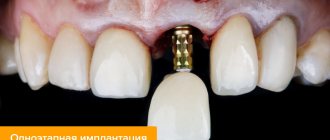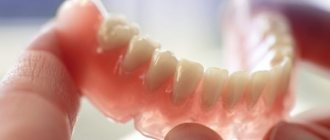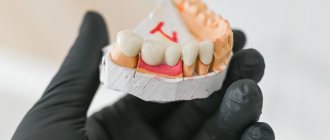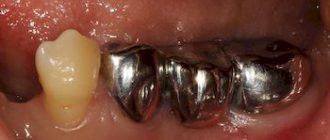From this article you will learn:
- what crowns are better to put on the front teeth,
- pros and cons of different crown options,
- How much does it cost to insert a front tooth?
When replacing anterior teeth, patients always place quite high demands on the aesthetics of dental crowns. The most important of them is that crowns on the front teeth should not be noticeable against the background of your own teeth, matching them in shape, color and transparency. The second important point is that crowns should not cause the gums to appear blue around them, because this will lead to its extremely aesthetically unsatisfactory appearance.
Today in dentistry there are only a few aesthetically acceptable options for prosthetics of anterior teeth. We are talking about prosthetics with metal-ceramics, zirconium crowns, as well as ceramic crowns “Emax” (glass-ceramics). Moreover, patients are equally often dissatisfied with both metal-ceramic and ceramic crowns, and below we will tell you why this happens and how to choose the most suitable option for you.
Metal-ceramic crowns for the front teeth: photo
The reasons for patient dissatisfaction lie not only in the low quality of work, but also in the initially incorrect choice of the type of crown, for example, not taking into account the level of transparency of the patient’s tooth enamel. The difficulty of choosing also lies in the fact that each of the types of crowns mentioned above (depending on the quality of the materials used and the manufacturing method used) can have either good or bad aesthetics. For example, let’s take economy-class metal ceramics made from budget ceramic mass “Duceram” (Germany).
Such metal ceramics can be found at an average price of 10,000 to 12,000 rubles. At the same time, the aesthetics of metal-ceramics made from budget ceramic mass will be very different from crowns that used more expensive ceramic mass, for example, “Noritake” (Japan), “Ivoclar” (Liechtenstein) or “Vita” (Germany). The average price for such metal ceramics in Moscow will be from 15,000 to 18,000 rubles. And if the metal ceramics were also made with the so-called “shoulder mass”, then you will have to add about 5,000 rubles to the price.
Important: we point out that within each type of crown there are numerous manufacturing options, the aesthetics of which will largely depend not only on the professionalism of the doctor and dental technician. Really good aesthetics will require more expensive materials and more labor-intensive manufacturing methods. But on the other hand, even choosing expensive ceramic crowns will not be an unconditional guarantee that you will get good aesthetics (since everything has its own nuances, which doctors often keep silent about).
Smile zone: indications for installing crowns
When communicating and expressing emotions, the teeth in the frontal region are involuntarily exposed. Their condition is visible to others, and this can cause psychological discomfort. If you are not happy with the appearance of your front incisors, contact your dentist. Even in the most advanced cases, when teeth are severely damaged, it is not necessary to remove them. After a thorough diagnosis, the doctor may recommend restoring teeth with crowns. A cap-like structure is placed over the remaining part of the tooth and takes over its functions.
Direct indications for depulpation
Dentists decide to remove a neurovascular bundle only if the patient:
- the nerve is partially exposed;
- tooth hypersensitivity;
- caries has reached the root canal;
- mechanical damage to the unit;
- anatomical pathologies (improper position of the tooth, large canal inclination).
The dentist is especially careful in choosing the method of prosthetics for the tooth that is planned to be used as a support for the structure.
Restoration with crowns is indicated in the following cases:
- aesthetic defects (chips, stains, cracks, diastemas, trema, curvature, etc.);
- single or complete destruction of teeth with preservation of the root;
- uneven gum line;
- bite pathology;
- pathological abrasion and discoloration of enamel;
- restoration of lost functions (biting, sharing food, diction).
The front incisors are not associated with the chewing function, so there are no strict requirements for the strength of the crowns. The doctor’s task is to recreate the anatomical shape and color of natural teeth, maintain their degree of transparency, and achieve a perfect match of sizes.
Stages of bite deformation in children and adults
Doctors distinguish several stages of bite deformation.
The first is considered the easiest. It is diagnosed when the patient has a curvature of one or more teeth - they may have an irregular shape or length, an abnormal inclination and location, or may be rotated around their own axis.
The second or middle stage involves malocclusion throughout the entire row on one jaw or both.
To the third, most severe stage, experts include pathologies associated with the abnormal structure and size of the maxillofacial apparatus relative to the skull, violation of the position of the upper and lower jaws relative to each other, and the degree of closure of the teeth.
Important! Any, even the most minor, deformation of the bite, at a minimum, leads to a violation of the aesthetics of the smile and facial proportions, and at a maximum – to serious health problems. For example, to dental diseases and gastrointestinal pathologies, to respiratory failure, hypertonicity of the masticatory muscles and overload of the maxillofacial joint, to headaches, to early loss of teeth.
Options for restoration of the anterior region with crowns
For patients and dentists, the front teeth have always been the most problematic. In the last century, people were given metal crowns to preserve chewing function. There were no other alternatives. Such structures coped with the chewing function, but looked very unaesthetic, oxidized, caused allergies and galvanic syndrome (taste in the mouth). The most expensive and fashionable were gold dentures. Products made of ductile metal did not oxidize, did not cause rejection, and did not wear out for a long time. But the shiny yellow crowns were conspicuous and did not look like natural teeth, so over time, fashion changed, and this restoration technology was replaced by more modern techniques.
Today, patients have the opportunity to painlessly and quickly get rid of all defects associated with damage or loss of teeth in the frontal area, including the complete absence of dentition. In shape, shade and transparency, artificial analogs are almost no different from natural teeth, and their strength allows you to forget about any problems for a long time.
Initial examination and diagnosis
The decision that a crown needs to be placed on a tooth is made by an orthopedic dentist after examining the patient’s oral cavity and teeth, as well as performing a number of diagnostic measures. Based on the data obtained, the orthopedist will develop a treatment plan, which may include not only the installation procedure itself, but also a number of additional measures:
- Professional oral hygiene, which allows you to clean your teeth from plaque and tartar;
- Removal of severely damaged teeth that cannot be properly treated and restored with a filling;
- Treatment of caries and any other diseases of the teeth and gums diagnosed during examination;
- Tooth removal, treatment and filling of canals.
Note that depulping a tooth before placing a crown on it is not always done. The depulpation procedure involves removing the dental nerve, after which the tooth becomes more fragile and vulnerable to external factors. If a tooth has more than one root and is in good condition, doctors prefer not to remove the dental nerve and put a crown on a living tooth.
When drawing up a treatment plan, the question of what kind of crown will be placed on the tooth is also decided. Modern dental crowns are made from different materials and there is always the opportunity to choose the version of the prosthesis that will most suit the patient in terms of aesthetics, price and durability.
The drawn up treatment plan is agreed with the patient and after agreement the treatment process begins. The first step is to prepare the tooth for the installation of a crown.
Types of dental crowns
In any clinic, patients can choose the type of future crown themselves, but without the help of a doctor it is very difficult to understand the types of prostheses, as well as evaluate the advantages and disadvantages of orthopedic structures. When choosing a crown, it is important to know what material it is made of.
✔
Metal ceramics.
✔
Solid ceramic.
✔
Ceramics E-max.
✔
Ceramic coated zirconium.
Metal ceramics
Products of this type have a very solid base. They create structures by alloying various metals: chromium, nickel, cobalt, gold, titanium. To make the dental crown look natural, the metal base is covered with ceramics. Layers are applied to the frame, after which the crown is fired to impart strength and integrity.
- Acceptable cost
- Wear resistance.
- Reliability.
- Change in color of soft tissues.
- Allergy to metal.
- Blueness of the gums.
- Significant grinding of the tooth.
Solid ceramic
When restoring teeth in the frontal zone, doctors recommend all-ceramic structures for aesthetic single prosthetics. All-ceramic crowns are made from pressed ceramic without the addition of additional materials. These are quite fragile products, so they are not used in the chewing department.
- Biocompatibility.
- Great aesthetics.
- Durability.
- Fragility.
- Impossibility of performing bridge prosthetics.
- Relatively high price.
E-max ceramics
The problem of the fragility of a material such as ceramics was solved by glass-ceramic crowns E-max. They are not only very durable, but also distinguished by high aesthetics. This is an excellent option for front teeth. The E-max crown looks natural and does not stand out among natural teeth.
- Strength.
- Aesthetics.
- Reliability.
- Natural transparency.
- High price.
Zirconium
In the popularity rating, zirconium crowns have been occupying first place for several years. In terms of strength, aesthetic products made from zirconium dioxide are not inferior to metal, which makes it possible to create orthopedic structures of the highest quality. The hard material enhances the strength of teeth and restores their size and shape.
- Excellent biocompatibility and thermal conductivity.
- Inertness of the material.
- Kink resistance.
- Lack of natural transparency.
- High price.
Ceramic crowns on a zirconium frame
This type of crown is an excellent opportunity to combine strength, reliability, and high aesthetics. The products are as reliable and durable as metal-ceramic crowns. They do not deform during use and serve for a long time. The ceramic layer gives the artificial tooth a natural appearance.
- They look natural.
- Hypoallergenic.
- Withstands heavy loads without risk of damage.
- Quite a high cost.
What are the advantages of a ceramic crown?
Today, ceramic dental crowns are the most aesthetically pleasing orthopedic structures installed both in the smile area and on chewing teeth. Ceramics is biologically inert and indifferent, is not perceived by the body as something foreign, does not absorb foreign odors, pigments and bacteria, does not emit harmful substances, and is also very durable. High-quality dentures cannot be distinguished from natural teeth.
3 main advantages of ceramic crowns
- Superior Aesthetics
- Hypoallergenic
- Reliability
How is prosthetics performed: stages of crown installation
Restoring teeth in the smile area is no different from restoring chewing units. The doctor performs standard procedures, but does so taking into account high aesthetic requirements. Crowns in the smile area should restore all lost properties of the tooth: color, shape, size, functionality. For prosthetics to be successful, the procedure is carried out in several stages.
- When restoring a natural tooth, the doctor carries out preliminary treatment: removes caries, bleeding, plaque, changes old fillings, cleans root canals, etc. After all dental problems have been eliminated, if necessary, a support for the crown is installed. A stump tab or a special pin is used as a supporting element.
- The tooth is ground to the required size and an impression is taken, from which a plaster model of the crown is made in the laboratory. To protect the ground element, the patient is given a temporary crown.
- Using special cement, the finished crown is fixed to the front tooth. Well-installed structures should not differ in shape and color, put pressure on antagonist teeth, or cause the sensation of the presence of a foreign body in the mouth. If prosthetics are performed professionally, the patient quickly gets used to the new artificial teeth.
Note!
If you experience discomfort or pain in your mouth, visit your dentist. The doctor will take an x-ray, which will help determine what the problem is and whether the crown needs to be removed to solve it.
Grinding teeth for crown installation
The professional name for the process of grinding teeth for installation of crowns is preparation, which is performed with a special device - a drill. Using diamond burs, the doctor gives the dental units the shape that will allow the crown to be firmly installed. Grinding can be a rather painful procedure for the patient if dental units that are not previously depulped are subjected to treatment. In this case, local anesthesia is required.
Natural tooth tissue is removed by a specialist to the thickness that the crown will have. On average, up to 2.5 millimeters of dentin can be removed from each side of the unit, depending on the type of crown prosthesis. Cast crowns require minimal grinding of teeth; maximum layers of tissue are removed before installing ceramic and metal-ceramic products. After grinding, a stump base remains from the tooth, on which the prosthetist will subsequently install a crown.
Is it possible to install a crown if there is no natural tooth?
In the absence of natural teeth, the integrity of the front row can be restored using implants. Carrying out implantation does not require turning of adjacent elements. The crown is placed immediately after the implantation of the artificial root. This process can last from 2 months to six months.
Before installing implants, the doctor takes impressions or conducts three-dimensional computer modeling to obtain a virtual model of the future structure. Before the permanent prosthesis is fixed, the doctor places a temporary crown on the patient.
When does pulp need to be removed?
Depulpation is not a mandatory procedure before prosthetics, but it cannot be avoided if there are the following indications.
- Advanced caries or caries at the very root of the tooth.
- Pulpitis or periodontitis.
- Partial exposure of nerves during grinding of enamel.
- Anatomically incorrect position of the tooth.
- Tooth injury, which may result in partial death of the nerves.
- Hypersensitivity.
- Low landing crown.
If there is a need to remove the nerve after the crown has been installed on a living tooth, then depulpation can be carried out without removing the crown. The doctor makes a hole, removes the nerve, and then fills the hole with polymer. After such a procedure, the prosthesis does not lose its performance properties.
Veneers or crowns: which is better?
You can restore your front teeth using veneers. Non-removable pads are attached to the turned elements. The procedure is much faster than prosthetics, but before making the final choice between veneers and crowns, consult your doctor. Durable ceramic onlays are classified as restoration methods in cosmetic (aesthetic) dentistry. Veneers that protect the surface of the tooth accurately imitate enamel, hiding all imperfections, but in case of significant damage and destruction they are not used. In these cases, crowns are installed.
If you have decayed or missing teeth and you are choosing how to fix it, you should know the advantages and disadvantages of the two most common replacement methods:
- bridge prosthesis,
- single crown.
This is especially important to know when the tooth requiring treatment or replacement is limited to healthy teeth.
A bridge is an age-old way to replace a missing tooth. The advantage of this method is that the patient quickly receives what he came for. It is believed that this is an accessible, inexpensive method.
However, it is worth considering that in order to restore chewing function and aesthetics, it is necessary to remove healthy tissue from adjacent teeth in order to secure the structure. Despite the widespread belief that this is an economically accessible, budget-friendly way to restore teeth, if you calculate everything correctly, the difference will be very small compared to the results. After all, the disadvantage of this treatment is that in order to install a bridge, it is necessary to grind down nearby healthy teeth to attach the bridge.
Previously, when there was no implantation technology, this method of restoration was one of the few possible solutions and made sense. Today there are still patients who, for some reason, do not want to install implants, are afraid of surgery, or have contraindications, and for them a bridge can be used.
Single crown. It is installed on a separate, independent structure – a dental implant. With this method, we do not affect nearby healthy teeth. There is no need to remove living tissue from them to secure the bridge. They do not take on additional unnecessary burden and, what is important, hygiene in this case is much better. The difference in price can completely cover the benefits that a single crown provides.
In the case of a bridge structure, if something happens to the supporting tooth on which it is attached, then everything will have to be redone. The likelihood of fracture increases due to the fact that the bridge structure distributes chewing forces and loads from the missing tooth to adjacent teeth. It is precisely because of overload that the loss of a nearby healthy tooth occurs. It can become loose, deteriorate and will eventually be removed.
If we are talking about a single crown, then the load from chewing falls on the tooth itself. Due to the fact that it is distributed directly to the bone tissue through the implant, and not to neighboring teeth, the jaw bone also does not atrophy.
A single-standing crown has good hygiene, which is carried out in the usual ways, but the care of a bridge structure requires special attention. At the same time, a single crown is much more aesthetically pleasing than a bridge. Its “technical inspection” and maintenance are much simpler, and it does not affect nearby healthy teeth.
The only small disadvantage of a single-standing crown on a dental implant is the treatment period. It takes some time for the implant to heal.
Demostom clinics employ highly qualified specialists, and we have significant positive experience in installing single implants. Our doctors work using modern technologies, using the latest, proven materials.
With us, single implantation is affordable, safe, modern and durable!
We can perform single crown installations to the highest standard.
Come to our clinics for a consultation with an orthopedist. He will assess the condition of your teeth, do the necessary research and prescribe the optimal treatment plan just for you. You will be able to understand everything and make the right choice.
Crown for front tooth: prices in Moscow
The cost of crowns is not affected by the type of teeth being restored, that is, it does not matter which elements the doctor prosthetizes, upper or lower. The price depends on the number of artificial crowns, the method of their installation, the material, and accompanying therapeutic procedures.
Information on the cost of treatment services can be found on the websites of dental clinics. We present average figures for Moscow.
The price of installing one metal-ceramic crown starts from 9,000 rubles. The cost of ceramic products is from 20,000 rubles. Costs for installing zirconium crowns start at 25,000 rubles. While the permanent crown is being made, the patient wears a temporary structure; it costs 1,500–2,000 rubles.
Taking impressions and making crowns
An impression is taken of the prepared dental units. For this procedure, a special dental plastic mass is used. An impression is necessary to make an exact plaster copy of the patient’s teeth, which will be used to create a permanent structure. For the production of crowns, different types of materials can be used - metal, metal-ceramics or ceramics. The specific type of raw material is selected based on the characteristics of the case and the wishes of the patient.
The production time for dental crowns depends on the type of material chosen. The production process of ceramic and metal-ceramic products takes the longest. If structures made from these materials are chosen for prosthetics, then temporary dental crowns made of plastic are made for the patient during the period of their manufacture. Temporary crowns will help to recreate the aesthetics of the dentition and, in addition, will protect the ground and weakened teeth from the destructive effects of external factors.
Ceramic veneering
Veneers are usually placed when the front teeth are slightly crooked. Dental veneers are installed very quickly, without the need for invasive procedures, and patients who decide to correct crooked teeth with veneers do not experience pain or discomfort. If you are looking for an option to correct crooked teeth for an adult patient, it makes sense to consider porcelain veneers. What you need to understand:
- Veneers cannot be placed on one or two teeth - the entire frontal zone (6-8 teeth) is treated.
- The cost of veneering will be higher than with prosthetics for one tooth, but the result will be the envy of Hollywood stars. The price of a veneer for 1 tooth according to the promotion at Amazing Price Dentistry is 12,500 rubles.
- Correcting crooked teeth with veneers will require 3 visits to the clinic.
Correction of crooked teeth - where to go?
A distinctive feature of Amazing Price Dentistry is an individual and comprehensive approach. During dental treatment, these problems as a whole are taken into account, not focusing only on its immediate solution, but on eliminating the cause. A holistic approach is provided by a multidisciplinary team of experts representing specific areas of dentistry, ensuring the best possible results. Teamwork and multidisciplinary consultations significantly reduce the risk of unwanted complications during treatment, and careful planning makes the process clear and transparent for the patient. If you are looking for a clinic that provides treatment in accordance with the highest international standards, we are waiting for you at any convenient time.
Do you have crooked teeth? What to do? – experienced Moscow specialists at Amazing Price Dentistry know. Make an appointment by phone, and dentistry together with the patient will find a solution that suits you in terms of execution time, effect and price.
Author:
Mayorov Andrey Mikhailovich
Specialization:
orthopedic dentistry, dental prosthetics, implant installation
Preparing for dental prosthetics
Many people do not like any dental procedures, and this is due to the fear of unbearable pain. You should not be afraid of dental prosthetics, since the most unpleasant thing you will encounter is tooth grinding and depulpation. And all procedures are carried out using local, good, strong anesthetics.
An important diagnostic point is x-ray examination to determine the number and size of roots.
Other stages of preparation include the improvement of neighboring teeth (removal of plaque, treatment of carious damage), which will serve as a support for the prosthesis. If the tooth is significantly damaged, they resort to extraction, treatment of the canals and their subsequent filling.
For prosthetic treatment of anterior teeth, as for any other manipulation, there are contraindications. They are divided into absolute and relative.
Absolute contraindications include:
- 3-4 stages of cancer;
- Conditions after chemotherapy;
- Immunodeficiency conditions;
- Severe somatic diseases in the stage of decompensated state;
Relative:
- Diabetes mellitus (especially type 1);
- Diseases of the heart and blood vessels, such as hypertension with crisis and angina pectoris;
- Smoking, alcoholism;
- Mental disorders;
- Pregnancy;
- Allergic reactions to dental medications and materials.


